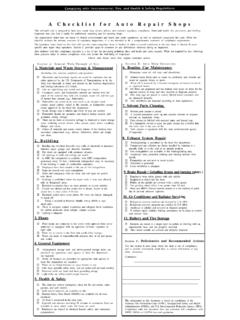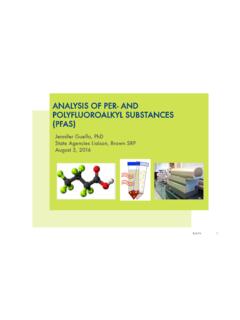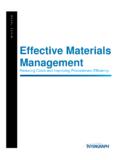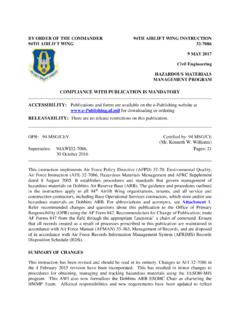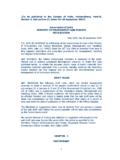Transcription of Construction & Demolition (C&D) Materials Management in ...
1 1 Construction & Demolition (C&D) Materials Management in the Northeast in 2013 December 7, 2017 Prepared by the NEWMOA C&D Materials Management Workgroup State environmental agencies in the Northeast have a responsibility to monitor and manage Construction and Demolition (C&D) Materials processing and disposal capacity. To fulfill this responsibility, they gather data from the C&D Materials processing, transfer, and disposal facilities that they regulate on the source of their incoming material , including imports from other states and the destination of outgoing material . This information helps them assess disposal capacity and measure recycling and other waste diversion activities. This document builds upon NEWMOA s 2009 Construction & Demolition Waste Management in the Northeast in 2006 report. The figures displayed below present available regional C&D Materials Management information for calendar years 2006 and 2013. The data is presented in three categories: disposal, landfill uses, and recovery.
2 Landfill uses include shaping and grading, road base, and alternative daily cover (ADC). Landfill uses are reported separately because they are not considered recovery in this data presentation. The data included in this write-up covers only C&D Materials that passed through a facility that reports to a state. For example, data on source-separated material sent directly from a C&D job site to a recycling facility, such as a metal scrap yard, is generally not available and, therefore, is not included in the figures on generation or recovery. Each graph that presents 2013 data is followed by one covering the same information from NEWMOA s report on 2006 data. This presentation focuses on the Management of C&D Materials in the Northeast , including Connecticut, Maine, Massachusetts, New Hampshire, New Jersey, New York, Rhode Island, and Vermont. Imports from and exports to non-NEWMOA states and/or Canadian provinces are aggregated into the Non-NEWMOA category in the figures.
3 Generally, the definition of C&D Materials includes wood, brick, concrete, asphalt pavement, metal, drywall, and asphalt shingles generated during the Construction , remodeling, or Demolition of structures. C&D projects can generate other wastes, such as plastic buckets, pipe and wrap, cardboard boxes, plumbing, electrical and other fixtures, wire, and rocks and soil that are also sent for disposal or processing. These other Materials are excluded to the extent feasible in the data regarding processing facility inputs and outputs presented below. At disposal facilities these other Materials are typically not identified separately and are therefore included in the C&D waste disposal data. Generally, interior finishing items, such as carpets and furniture, are also not considered C&D waste, but in practice could be included in Demolition waste. Data on the recovery of these other wastes is not included in this presentation. 2 This presentation only includes available data from processing facilities that handle mixed C&D Materials from building Construction , renovation, and Demolition projects.
4 NEWMOA excluded data from facilities that only process material from road and bridge projects and from facilities that exclusively process material from land clearing projects, to the extent feasible. The quantity and weight of asphalt, brick, and concrete (ABC) generated by road and bridge projects often dwarfs the amount generated from other sources, particularly architectural sources. Facilities that handle mixed C&D Materials received and recovered ABC Materials from building projects and data on ABC from these facilities is included in this presentation. Likewise, some processors of mixed C&D Materials also received land clearing debris, and data on clean wood recovery from these facilities is included. Clean wood can also include shipping pallets and lumber from new Construction or from uncoated lumber from renovation and Demolition projects. Construction & Demolition Materials Workgroup The purpose of NEWMOA s Construction and Demolition Materials Workgroup is to oversee NEWMOA s C&D Materials data collection and analysis and the development of this presentation, and to share other information and lessons learned about the Management of this large and important waste stream.
5 The NEWMOA states solid waste program directors appoint representatives to serve on its Workgroup. Data Analysis Methodology NEWMOA followed the data quality assurance procedures in its EPA-approved Quality Management Plan ( ) to prepare this presentation. Workgroup members shared summaries of the C&D Materials data collected from regulated facilities when it became available. Prior to sending NEWMOA staff their state s data, the Workgroup members conducted their own quality assurance review. Each state program shared their data in different formats, with some state programs sharing data from individual disposal, transfer, and processing facilities, and some providing data that they aggregated across facilities. NEWMOA staff reviewed, evaluated, and aggregated this data and contacted the appropriate Workgroup member with any questions. NEWMOA staff entered the aggregated data into a Microsoft Excel spreadsheet and prepared draft figures. The Workgroup members reviewed a draft of the data, figures, and text and provided comments and corrections.
6 After the NEWMOA staff made the recommended corrections, a revised draft was shared with the NEWMOA Board of Directors and the Solid Waste and Sustainable Materials Management Steering Committee for their review and approval prior to publication online. Data Caveats Workgroup members addressed discrepancies that arose after NEWMOA staff compiled the C&D Materials spreadsheet and reviewed the results. A typical discrepancy involves a situation where the waste export data from transfer facilities in one state differed from import data from disposal facilities in another state. Unless otherwise noted below1, the figures that present disposal data are based on information from the disposal facilities, since the Workgroup 1 2013 disposal facility data was supplemented by data provided by CT DEEP for exports to MA, NY, and RI from CT, and by VT DEC for NH and NY imports from VT. 3 considers their data to be most accurate.
7 When supporting data is available, NEWMOA staff adjusted the submitted data for various reasons, including: If a C&D Materials load is hauled directly to an out-of-state processing facility, disposal facility or transfer station, the material does not pass through a regulated facility in the state of origin (called the generating state) and, therefore, that generating state does not receive a report on it. When C&D Materials are transported from a facility in the generating state to a processing facility or transfer station in another state, and then from there the outputs are sent to another facility (either in that second state or to a third state) for further processing or disposal. That receiving facility might record the C&D material as originating in the second state rather than the generating state. Possible double-counting can occur when a transfer station or processing facility transfers some, or all of its incoming material to another processing facility within that same state.
8 This material might be counted as new incoming material to each facility when it should only be counted once. When states used different terms for similar Materials , as illustrated in the following table regarding wood: State Name Used in Processing Facility Data Reported to NEWMOA Counted as Clean Wood in this report Counted as C&D Wood in this report CT Wood X ME CDD Wood Fuel Chip X CDD Treated Wood X Wood from CDD X Wood Waste Fuel Chip X Land-clearing/Wood Waste X MA Wood C&D X Wood Waste X NH C&D Wood X Unadulterated Wood X NY Wood (chips) X Wood (unadulterated) X Wood (unadulterated pallets) X RI Landscaping Chips X Wood Fuel X By carefully reviewing the available C&D Materials data, NEWMOA staff identified and adjusted for these situations to the extent feasible, and the figures reflect these and other corrections. Notes on the States Data The following sections highlight unique features regarding states C&D Materials data that should be noted when reviewing the figures below.
9 4 Connecticut: The Department of Energy and Environmental Protection (DEEP) does not receive reports from processing facilities on the quantity of exported material that is used as ADC instead of disposal. Therefore, all exports are reported as disposed of, and this could over-report disposal and under-report landfill use for Connecticut. New Jersey: The Department of Environmental Protection (DEP) collects extensive data on the outputs from processing facilities that manage C&D and other Materials , but does not collect data on the sources of the incoming material , which could be municipal solid waste, road and bridge project ABC, building project C&D Materials , or other sources. Therefore, for New Jersey, this presentation only includes data on C&D waste disposal and does not include information regarding processing and recovery. New York State: The Department of Environmental Conservation (DEC) collects data from C&D Materials processing facilities that include many that process road and bridge, and land clearing Materials .
10 NEWMOA removed data from facilities that deal primarily with these Materials . However, NEWMOA s staff was unable to resolve discrepancies between the quantity of material reportedly received versus removed at several facilities. This creates uncertainty in the data reported for New York. In 2006, recovery data for New York included other Materials , such as paper, plastic, rock, and soil. In the 2013 presentation, this material was excluded. Data regarding processing facility outputs is categorized in the DEC system as destination , recovered , and transferred . Generally, destination means sent for disposal, recovered means recovery for reuse/recycling, and transferred means transferred for further processing. However, by examining the facility-specific data it became clear that several processing facilities were reporting recovered material as transferred when it was sent to a recycling facility. NEWMOA staff adjusted the data to account for this to the extent feasible.

